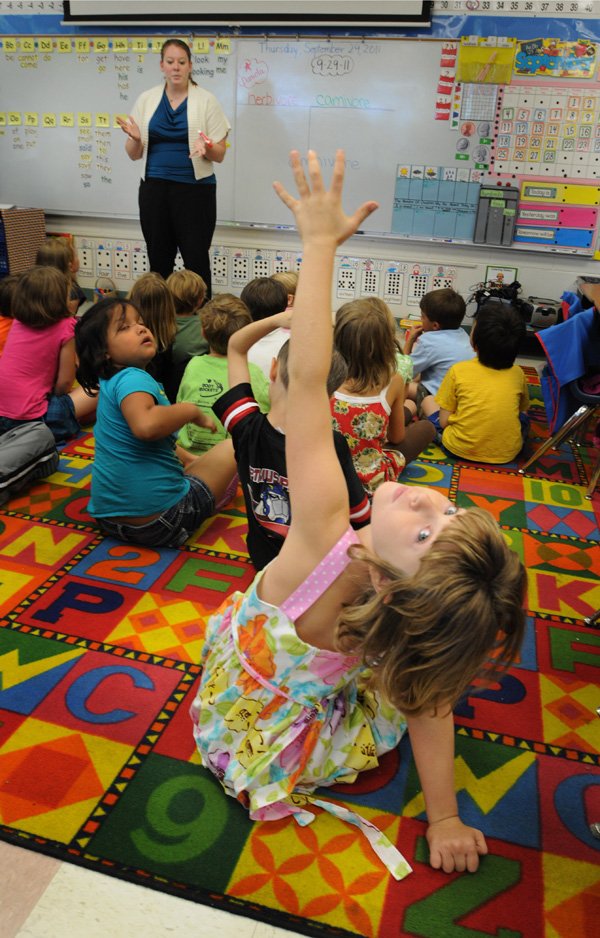The new Common Core education standards take students way beyond Dick and Jane, the children who lived on Pleasant Street with their baby sister, Sally, and their dog, Spot, and helped children learn to read in the 1940s or 1950s, even into the 1960s.
Learning to read was built around Dick and Jane’s family in those days.
Now, kindergarten, first- and second-grade teachers have spent the first weeks of this school year grappling with what some educators called the largest shift in curriculum and standards in their careers.
The new standards’ focus on depth rather than breadth of study. Teachers said that shift is exciting for them and their students, even though the change has its challenges.
“It’s more work, but it’s definitely worth it,” said Joey Barnes, a second-grade teacher at Russell D. Jones Elementary School in Rogers. “I’m corny. I went into this to make a difference, and I didn’t feel like that was happening so much before.”
Students are more engaged and are taking an ownership in their learning, said Kerry Boles, a first-grade teacher at Shaw Elementary School in Springdale.
Implementation
At A Glance
What Is Common Core?
The Common Core State Standards Initiative, coordinated by the National Governors Association Center for Best Practices and the Council of Chief State School Officers, attempts to provide a clear and consistent framework to prepare all children for college and the workforce. The standards define the knowledge and skills students should have within their K-12 education careers so that they will graduate high school able to succeed in entry-level, credit-bearing academic college courses and in workforce training programs.
Source: Staff Report
The Common Core state standards will be fully implemented by 2014, but students in kindergarten through second grade in Arkansas started using the standards this year. In Springdale, the school district opted to move all grades to the new standards this year.
The standards replace the Arkansas Curriculum Frameworks, which has guided teaching in Arkansas for more than a decade.
Common Core, which has been adopted by at least 46 states, including Arkansas, and the District of Columbia, grew out of efforts by the National Governor’s Association and the Council of Chief State School Officers.
The standards are a lengthy set of expectations that establish when students should acquire certain skills and knowledge.
For example, the dozens of requirements for second-graders include distinguishing long and short vowels, reading grade-level text aloud, understanding odd and even numbers and measuring the length of objects.
“Much more rigor is included in the Common Core standards as to what we’re dealing with in the Arkansas frameworks,” said Kay Jacoby, executive director of curriculum, instruction, assessment and accountability in the Fayetteville School District.
In a fifth-grade classroom at Shaw Elementary School in Springdale, students worked with popcorn kernels to compute distance and diameter of planets in the solar system and their distance from the sun. One kernel equaled 10 million miles, said Tina Blythe, a science and math teacher.
“What I have found is that science and math are so related,” she said. She taught math for 17 years before taking on the science assignment this year, noting the implementation of Common Core means much more studying on her own time to help her students.
Integration
Common Core also means more integration. Students are studying the science concepts of Galileo while reading about Leonardo di Vinci in a unit on the Renaissance, Blythe said.
Another Glance
Developing Assessments
The Partnership for the Assessment of Readiness for College and Careers is an alliance of 24 states, including Arkansas, working together, to develop common assessments for Common Core states. Those states have an estimated 25 million students. The partnership’s work is paid for through a four-year, $185 million dollar grant from the U.S. Department of Education. Some 200 higher education institutions and systems will help develop the high school component of the new assessment, then use it as an indicator of student readiness for college work. The partnership’s goal is to make sure all students graduate from high school college- and career-ready.
Source: Staff Report
In her first-grade classroom, Boles said her students are reading nonfiction texts to learn about the animal kingdom, animal classifications and habitats. The unit on animals also includes science, social studies and math.
Classrooms are no longer quiet with desks in a row and a teacher at the front of the room, Boles said.
“It’s collaborative learning from each other. The teacher is the guide,” she said.
Boles no longer has a desk of her own in her classroom because she spends so much time at computer stations or on the floor with her students.
Springdale teachers have been implementing more collaborative projects for students for the last several years.
“Common Core allows us to go much deeper,” Boles said. “The kids are excited about it. Everyone in the country is on the same page.”
Blythe said the Arkansas frameworks for fifth-grade science are 15 pages for one nine-week period.
“Common Core condenses it to be more meaningful in the classroom,” she said. “Nothing is taken away or nothing is added.”
The teachers agree students will be better prepared for college or to compete for jobs under Common Core.
Challenges
Still there are challenges.
Blythe said she is spending three to four hours at night learning the new material her students will need to know as they move through the common core standards in science.
Delia Gorder, who teaches first grade at Root Elementary School in Fayetteville, said the math standards are more difficult to teach than the English language arts.
Change is difficult by itself but teaching under Common Core is challenging without clearly defined resources or assessments, Gorder said.
“We have no assessment to drive our instruction,” she said. “There is no guidance to know where we are going.”
Literacy, on the other hand, has been less challenging.
“Kids are loving the nonfiction,” Gorder said.
Teachers also are trying to improve writing skills among the first-graders, something Gorder loves.
“Writing is hard for a lot of kids,” she said.
First-graders in her class are already working on paragraph writing and sentence building, not just in language arts but in science and social studies.
“Arkansas jumped on the bandwagon and teachers are paddling as fast as we can,” Gorder said. “I know we’re going to get there.”
Common Core standards in math require teaching concepts and skills at an earlier age, Jacoby said. For instance, what students previously learned in sixth grade will be introduced in fourth grade.
Susan Hill, a second-grade teacher at Jones Elementary in Rogers, said that under the old system, she would focus on different math ideas for short periods, have students complete worksheets and then move onto new concepts.
Now students spend time working on why 2 plus 2 equals 4, Hill said, not just memorizing the equation.
Hill and Barnes said worksheets have been virtually abolished from their classrooms. They’ve been replaced by projects and journals, which Hill and Barnes said give them a better idea of what their students understand and what they’re struggling with.
“With a worksheet you just say ‘Oh, that’s the wrong answer’ and mark it,” Barnes said. “With a journal you can see what they don’t understand.”
In English language arts, there is a greater emphasis on nonfiction text at earlier grades without a lot of resources to support the teaching, Jacoby said. Another difference is that persuasive writing will be taught in the third grade.
“The whole curriculum is being ratcheted up, including assessments and accountability,” Jacoby said. “We expect kids to do more than ever before.”


